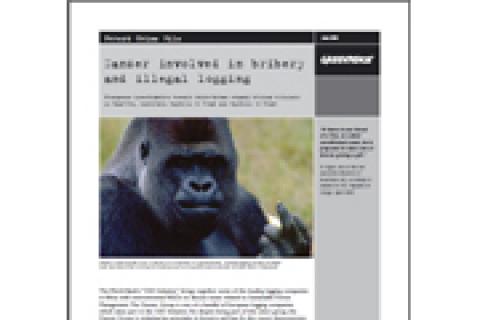Greenpeace investigation reveals Swiss-German company bribing officials in Cameroon, Democratic Republic of Congo and Republic of Congo.
Download full document as pdf
Other information
From May 3 to 14, 2004, governments from around the world met in the hallowed halls of the United Nations in Geneva, Switzerland for the fourth session of the United Nations Forum on Forests (UNFF4). Eleven members of the Global Caucus on Community Based Forest Management attended the first week of UNFF4, with the aim of learning about the UNFF process, and where possible, to advocate for community based forest management. It is fair to say that the Caucus’ expectations for UNFF4 were low in terms of what we anticipated governments would achieve through their deliberations.
Freddy Molina is a board member of the Asociacion Coordinadora Indigena y Campesina de Agroforesteria Comunitaria Centroamericana (ACICAFOC). In English, this translates into the Coordinating Indigenous and Peasant Farmers Association on Community Agro-Forestry in Central America. ACICAFOC is a non-profit, social community-based organization from Central America, which brings together associations, cooperative societies, federations and grass roots organizations lead by small and medium agro forestry producers, indigenous peoples and farmer peasants.
Maybe it's something in the water in Geneva that causes temporary memory loss. Or maybe it's the coffee. Whatever, the participants at the fourth meeting of the United Nations Forum on Forests (UNFF-4) held in Geneva in May seemed to be suffering from a form of collective amnesia.
ENGLAND, UK, APRIL 19TH, 2004.
Today, over fifty environmental and social justice NGOs and other groups sent a letter of protest to the World Bank calling for the closure of its new emissions trading fund, The Prototype Carbon Fund.
Among practices that are emerging in the conservation of Kenya’s forests is the participation of communities in forest management. Although the communities are at the moment being involved at a minimal level, many communities living next to forests now want to make decisions and benefit from sustainable use and management of forests.
This desire for participation has been fueled by provisions of the soon to be enacted Forest Bill that will replace the current Forest Act, as well as the work of non-governmental organizations such as the Kenya Forests Working Group (KFWG).
Forests and woodlands cover about 24% (or 5 million hectares) of the total land area of Uganda, of which 80% is woodland, 19% moist high forest and 1% commercial plantations. Approximately 30% of such forests and woodlands are gazetted mainly as protection forests directly under various forms of government jurisdiction. The 70% outside the gazetted forest domain exist under various forms of private and customary control.
At the end of a National Conference on Community Ownership of Forests (April 2-4, 2004), organised by Jharkhand Save the Forest Movement, National Forum of Forest People and Forest Workers, and Delhi Forum, held in Chalkhad, a forest village in the Indigenous Peoples majority State of Jharkhand in eastern India, around two hundred indigenous Munda (a central Indian indigenous ethnic group) representatives resolved in unison to “Oppose World Bank: And Save Forests”.
Indigenous communities have been practicing sustainable community-based ecosystem management for centuries. These systems incorporate local knowledge and beliefs that are based on the wisdom and experience of past generations. They also contribute to the economic well being of local communities, as well as to the well being of the Indonesian nation.
Over the past few years, private conservation has covered close to a million hectares in the South of Chile, surpassing the forest areas under regulated community land tenure, and making it comparable to the previous expansion of pine and eucalyptus plantation companies, today exceeding 2 million hectares.
The Uitoto peoples in the Araracuara region, in the mid course of the Caqueta River show some common socio-cultural characteristics, among which a production system based on the sustainable use of three spaces: the forest, the river and the “chagra” (a clearing in the forest used for poli-culture plantation).
The United Nations Framework Convention on Climate Change (UNFCCC) has been in force since 21 March 1994. For a decade, international climate change negotiators have filled meeting rooms with hot air. Meanwhile, greenhouse gas emissions have increased by 11 per cent, according to World Resources Institute.
Yet when more than 5,000 participants descended on Milan for the ninth Conference of the Parties to the UNFCCC (COP-9) in December 2003, reducing greenhouse gas emissions was not on the agenda.


